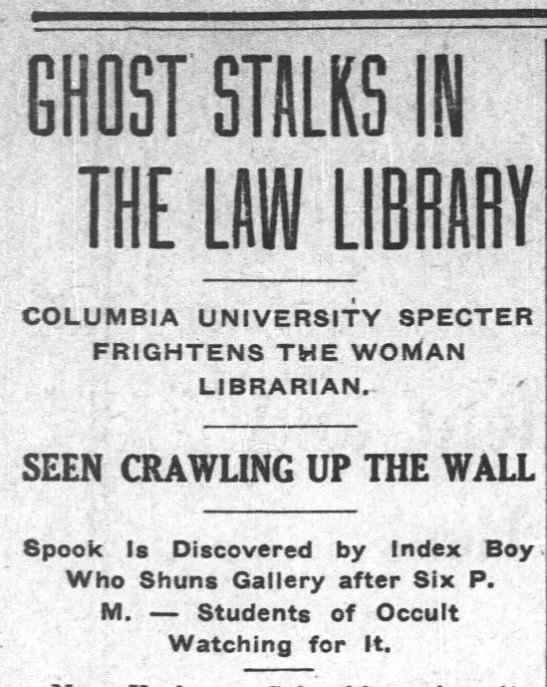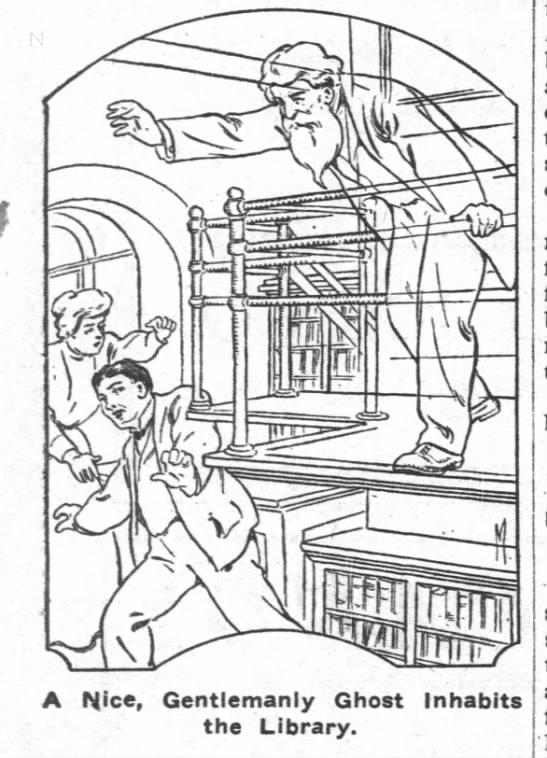 |
| Via Newspapers.com |
I always say, nothing completes a library quite like a ghost. And if it’s a “nice, gentlemanly” one, all the better. From the “Great Bend Daily Item,” July 25, 1908:
New York.--Columbia University holds that ghost stories may be dismissed with a laugh, until an educated, nice, old gentlemanly ghost gets to hovering 'round Columbia's library building of nights. In other words, there is an undeniable ghost in Columbia's law library, and, as the undergraduates say: "Whatd'ye know about that?"
Three weeks ago the Century club, of Forty-third street, borrowed four portraits of the Columbia law library to hang in a portrait exhibition. They were the portraits of Chancellor Robert E. Livingston, Chancellor Kent, Theodore Dwight, Columbia's old law professor, and Charles M. de Costa, lovingly remembered at the university for a wad of money he bequeathed it. All four came back about two weeks ago in good condition except the de Costa picture, which had a check or two on its varnish. The Century club, being notified, took the canvas to a restorer, leaving where of old the portrait used to hang a bright green spot on the otherwise faded green burlap wall.
Three days ago, at 6 p.m., John Henry, the library's card index boy, rushed from the library gibbering. Miss Cox, the assistant librarian, captured him. "Not again," wailed John through his chattering teeth. "I don't go in there no more; there's a man crawlin' on the wall where the picture was. I don't go back for no money."
Miss Cox entered the library full of scornful unbelief and turned on the electrics. All was as it should be, a bright green oblong on a faded green ground with a book gallery running below it and--
Suddenly a peal of laughter broke in the room and two cases of books on either side of the picture spot emptied their contents with a crash. When Miss Cox found herself in the outer hall, John Henry had gone.
In the morning a watchman reported to Dean Kirchmey that "a kind of a glow" had been visible through the glass doors of the room all night.
Only a few summer and "conditioned" students haunt the library these days. That evening at six (as before) one of them, prowling for a book in the half light of an upper gallery, heard the scratch of a pen writing, writing.
He traced it to the olive green oblong on the blank wall and marched over at once. The pen scratching ceased, but as he stood before the picture spot there rose from the floor a prodigious hollow sigh. The student ran.
With a classmate he returned to the library on tiptoe. The room was vacant, but on the haunted picture spot there glowed an outline of the features that once adorned it, rimmed with a phosphorescent frame. As the youths stared, the face and frame dissolved and the bent figure of a man came out upon the gallery, scurried to the furthest wall and blended with the books. As he vanished they heard a sigh.
The apparition picture, the fleeting figure in the galleries and the hollow sigh have become commonplace now. Even John Henry, the card index autocrat, enters the library without fear in the day-time. For scholarly Columbia is taking its ghost in a cold, scholastic spirit, and already has his nightly walk scheduled for six o'clock evenings, from which hour the ghost has not deviated an iota.
Prof. Hyslop, it is understood, is on the job with other students of the occult, and will conduct a series of experiments with the ghost and the ghost's picture. Possibly, it is said, he may endow science with a pamphlet.
In the meantime, in the daytime, last year's "canned" students continue to work off conditions, John Henry shuffles the index cards and Miss Cox enters names against missing law books.

That's kind of creepy, especially if the ghost is that of a former personage of the university. But I like best the phrase in the newspaper clipping: "Index Boy". What sort of powers would that super-hero have?
ReplyDelete